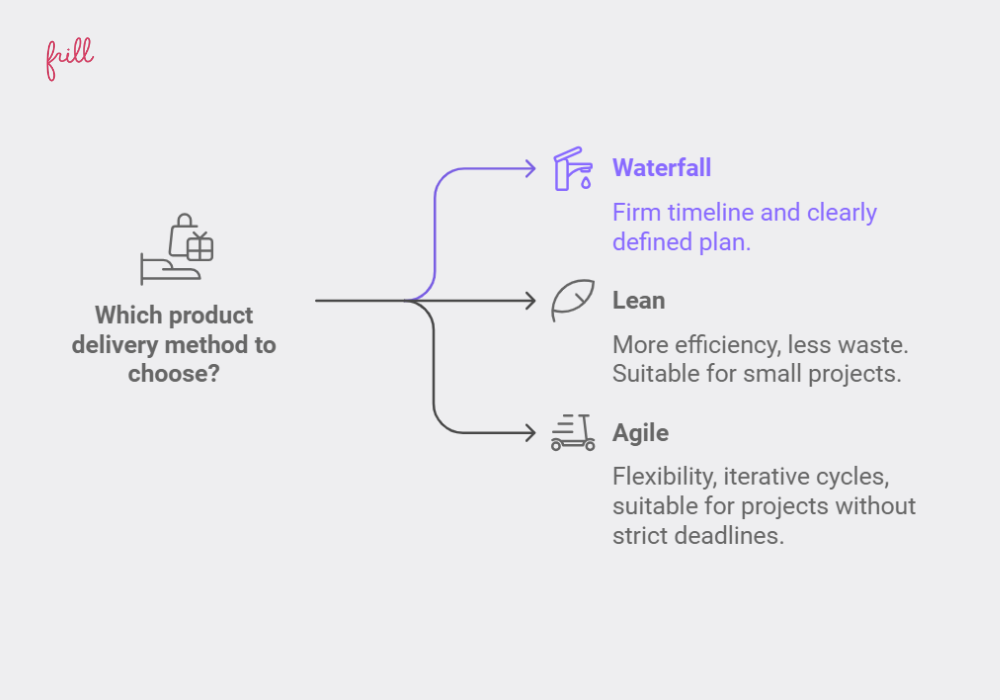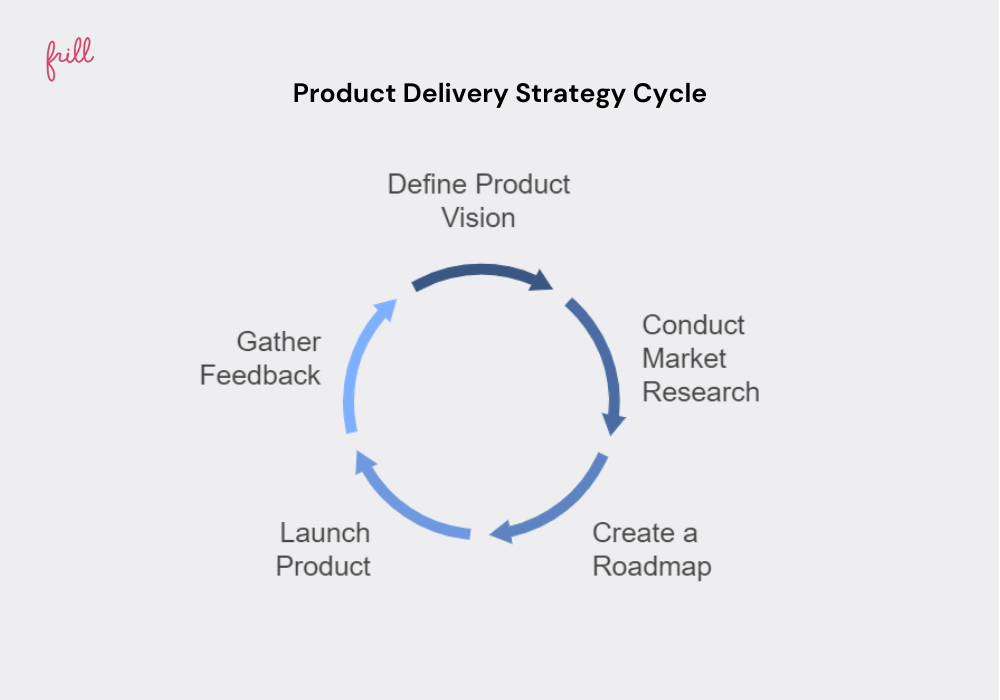Product Delivery: The Key to Successful Products
Last updated on Sun Nov 10 2024
Crafting a successful product is possible with the right strategy and practical implementation. Having a beautiful product idea is one thing. The main challenge comes with making that idea transform into reality. Many brilliant ideas have died from the “poison” of delays, deadlines, or even the dreaded scope creep. Product delivery is not an easy task. However, it can be simplified using the proper knowledge.
In the following sections, we’ll explore all that is key to the success of product delivery.
From Missed Deadlines to Success
Frankly, product delivery is challenging. Difficulties will arise, and test the product’s progress. Due to the human and financial investment products often demand, these setbacks can be discouraging. Consequently, you must learn product delivery strategies. You cannot avoid every problem, but the right product delivery strategy turns problems into opportunities and keeps you in control. You should no longer worry about setbacks but plunge forward with resilience.
What Is Product Delivery?
Product delivery is the road between a product idea and the finished product. It takes us from the abstract to the concrete, from imaginary to reality. Product delivery encompasses all the steps involved: development, testing, marketing, and distribution. In addition, it requires numerous hands. Developers collaborate with the sales teams, marketers, and stakeholders to accomplish the task.
Each step is essential in the overall process. The development phase involves constructing the product, after which you test it to ensure it functions as intended. Once the product is ready, the marketing step gets the word out. Lastly, customers receive the product.
For a comprehensive roadmap, check out these product roadmap templates.
The Role of Product Delivery Teams
Product delivery involves the effort of different teams working together to achieve harmony and align with the vision.
The first, which is essential, is the developers who build the product. They make sure the product works as it should. Next, we have the testers who check on product quality. Marketers come third on the list, bringing customers to the product.
Marketers work with the sales team to bridge the gap between the customers and the business. Finally, the product delivery manager acts as an adhesive in the process. Our expert guide to the product management process explains this more.
The Importance of a Product Delivery Manager
The product delivery manager (PDM) is the leader and thus carries enormous responsibilities. An excellent delivery manager is critical to the product's success. As the leader, the PDM oversees the work of other teammates. He can be a software designer, UX designer, or QA tester. The product delivery manager should be distinct from the product manager, though their roles are linked. The product manager provides the problem, while the product development manager provides solutions to the problem.
The product development manager has numerous responsibilities besides coordinating the teams. They also handle deadlines, interact with stakeholders, and engage customers to gather feedback. Customer feedback is essential, and you can gain more insight through our guide to customer feedback management for SaaS.
Methods for Product Delivery

The demands of your product largely determine the method you choose. The team isn’t limited to one method and should weigh all available options before settling for one. Below are some approaches:
1. Waterfall
The waterfall model is named after its flow, as each phase ends where the other begins. It is a great method if you have a firm timeline and a clearly defined plan. The six Waterfall phases include requirement, design, development, testing, deployment, and maintenance.
2. Lean
The Lean model follows a motto: More efficiency, less waste. Teams who use this work prioritize focus, starting with the main features. The Lean model is only for some, though. You can’t use it for a large project that needs what the Lean model classifies as waste.
3. Agile
Agile is a best friend of flexibility, offering a more “create as you go” approach. Do you remember how the waterfall model values structure? Well, Agile is the opposite. It is more like running sprints than a marathon.
Agile breaks the project into iterations/cycles, with feedback refining each cycle. It has its perks, but it’s not for everyone. For instance, we don’t advise Agile for teams with a deadline to meet.
It would take more space than we have to explain each method, so feel free to explore in our guide to feature discovery.
Creating a Winning Product Delivery Strategy
Alright! So far, you have substantial information in your toolkit. You know what product delivery is, each team member's role, and the work of the ship’s captain, the product delivery manager. You also know the most popular methods. Let’s get on with the strategies now, shall we?
Here is a five-step process:

Step 1: Define your Product Vision
If product delivery is a house, the product vision is the foundation. We can’t talk about product delivery (or any project, really) without the product vision. Your vision should motivate teammates, capture customers' potential needs, and inspire investors to fund it. Otherwise, what is the point?
Step 2: Conduct Market Research
The product is more for your audience than your team. This mentality should push you towards extensive research. Product delivery is not only about profits but also about positively impacting people’s lives. Therefore, you need accurate data on what your audience wants. Market research is your guide. As you research, answer questions about the customers’ pain points, preferences, and needs.
Step 3: Create a Roadmap
Not just any roadmap but a detailed one. The roadmap is your treasure map, with the finished product as the “X.” In the product roadmap, include all the needed steps, the expected role of each team member, and milestones. The roadmap doubles as a guide and a checklist.
Step 4: Launch
Launching is a big moment and comes with a lot of pressure. That’s why we offer a product launch communication plan to assist in setting a strategy. Coordination is a non-negotiable in this step, which calls for proper communication. Every team member is important in the launch step.
Step 5: Improvement
Every process has room for improvement. The same rule applies to product delivery. Meet customers through feedback methods to learn their thoughts and use the data for growth. Each product is incomplete at its first launch. That’s why we have updates.
Measuring Product Delivery Success
How do you know if your product delivery is successful? Check how your customers respond. You can check the customers’ responses through direct feedback and analyzing their behavior. You should also be conscious of the product quality, knowing that depreciation lurks in the corner.
Therefore, your metric for success should include:
Direct customer feedback
Product Quality
Business Impact
Cycle Time
Lead time
You need the right tools. Our post on product management software is here for you.
Common Product Delivery Challenges
Any compelling plan accounts for potential challenges and how to solve them. In product delivery, you can foresee common difficulties hindering progress for every team. One of them is scope creep, where the product demands more resources than you planned. The scope creep can cause resource constraints, delaying and even terminating the process. Quality issues are additional challenges.
Fortunately, these challenges have solutions. Always start with your goals and keep them at the forefront because they decide your feature priorities and allocation of resources. In addition, use robust testing to detect issues early. As an additional resource, check our guide on the feature prioritization matrix.
Conclusion
It’s good to acknowledge that product delivery is complex, but there’s no room for despair. The right strategy, coupled with a focus on customers, cancels difficulties. Opt for the proper method to reach your goals, and remember to improve constantly.
As a thank-you gift for reading to this point, here is a guide to product management process.
FAQs
What Are the Popular Product Delivery Methods?
The popular product delivery methods are Agile, Lean, and Waterfall. Each has pros and cons, so use our guide to feature discovery to choose wisely.
What Is the Product Delivery Manager's Role?
The product delivery manager plays a decisive role in the process. They act as overseers and play many roles. The PDM ensures harmony, proper communication, the timeline's follow-through, and the quality of the product.
What Is an Effective Product Delivery Strategy?
An effective product delivery strategy follows a certain set of steps, which starts with defining a product vision and conducting proper research. To help you create a good plan, here are our Product roadmap templates.